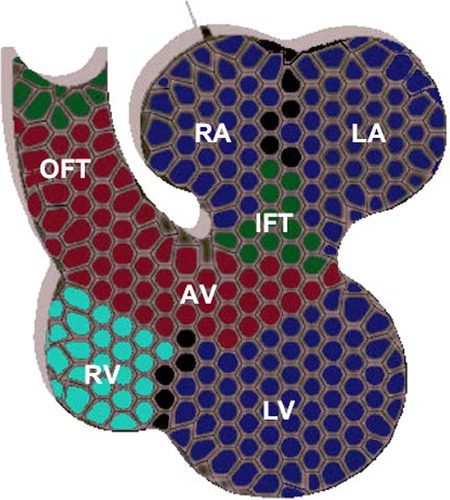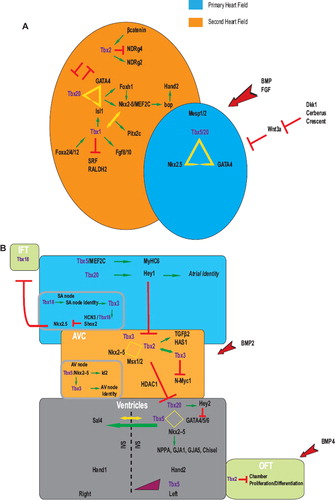Figures & data
Figure 1. Neighbor joining phylogenetic tree based on the conservation of the T-Box domain in two species (Homo sapiens and Bronchiostoma). The full alignment profile of the studied sequences was created in Phylip format (Citation31). The distance matrix was calculated using the Kimura model implemented in T-Rex software (Citation32).

Figure 2. Expression of T-box proteins in the mammalian multi-chambered heart. TBX20 is expressed throughout the heart (gray), whereas TBX5 (blue) is expressed in in both atria (RA and LA) and ventricles (RV and LV) with a gradient pattern in the ventricles from left (highest) to right (lowest). TBX2 and TBX3 (red) are both expressed in the outflow tract (OFT), the atrioventricular (canal), and the inflow tract (IFT). TBX1 is restricted to the upper arterial trunk, whereas TBX18 is expressed in the sinus horns and node (green).

Figure 3. T-box proteins are involved in a complex network of interactions during heart development. (A) Combinatorial interactions of T-box proteins with a number of transcriptional factors function to regulate primary and secondary heart field identities early on in cardiac development. (B) Cardiac specification is tightly modulated and involves different T-box proteins that act in concert to direct distinct regulatory networks promoting proper cardiac architecture. Aberrations in these networks have been linked to congenital cardiac defects. See text for more details. Red arrows represent inductive stimuli. Red perpendicular lines indicate inhibition whereas yellow triangles, squares and arrows indicate interactions. Positive regulatory effects are shown in green.

Table I. Classification of the distinct mutations associated with the cardiac T-box proteins underlying congenital heart anomalies.